Business Decision Analytic Report: Decision Making Process Analysis
VerifiedAdded on 2021/10/27
|20
|5237
|401
Report
AI Summary
This report provides a comprehensive analysis of the business decision-making process, outlining a structured approach to problem-solving. It begins with problem definition, emphasizing the importance of identifying constraints and goals. The report then delves into situational analysis, using tools like SWOT and PESTL to understand internal and external factors influencing decisions. Sense-making, including the use of root cause analysis, is highlighted as crucial for understanding complex situations. The formulation of potential solutions, with an emphasis on value-focused, technically sound, and consistently defined alternatives, is discussed. The report then addresses solution selection, emphasizing the use of tools like solution-selection matrices. Finally, the report covers decision implementation, testing, and team feedback, providing a complete overview of the business decision-making process and its various stages and methodologies. The context of the report focuses on a business facing product failure due to government policies, with a need to address employee salaries and potential reductions.
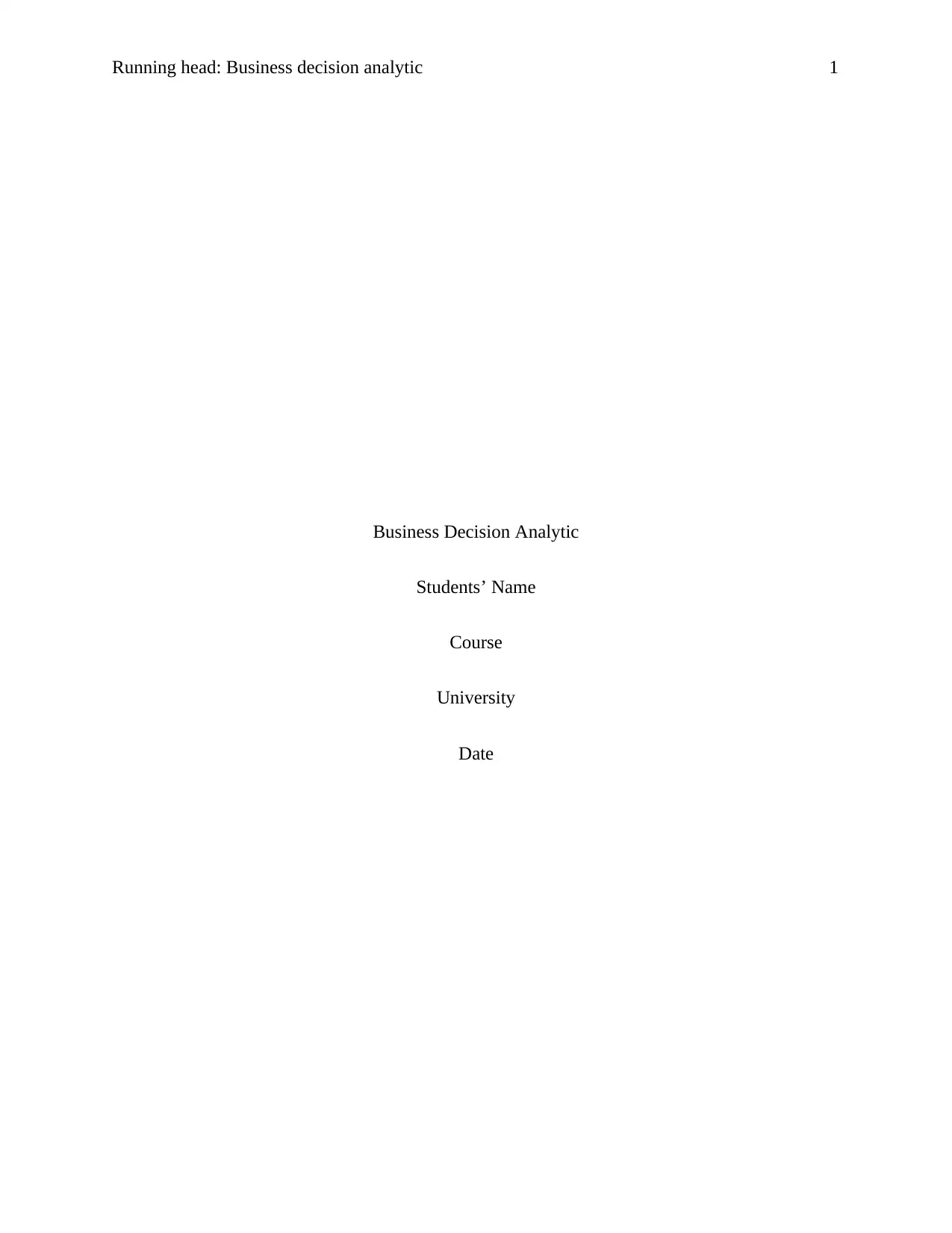
Running head: Business decision analytic 1
Business Decision Analytic
Students’ Name
Course
University
Date
Business Decision Analytic
Students’ Name
Course
University
Date
Paraphrase This Document
Need a fresh take? Get an instant paraphrase of this document with our AI Paraphraser
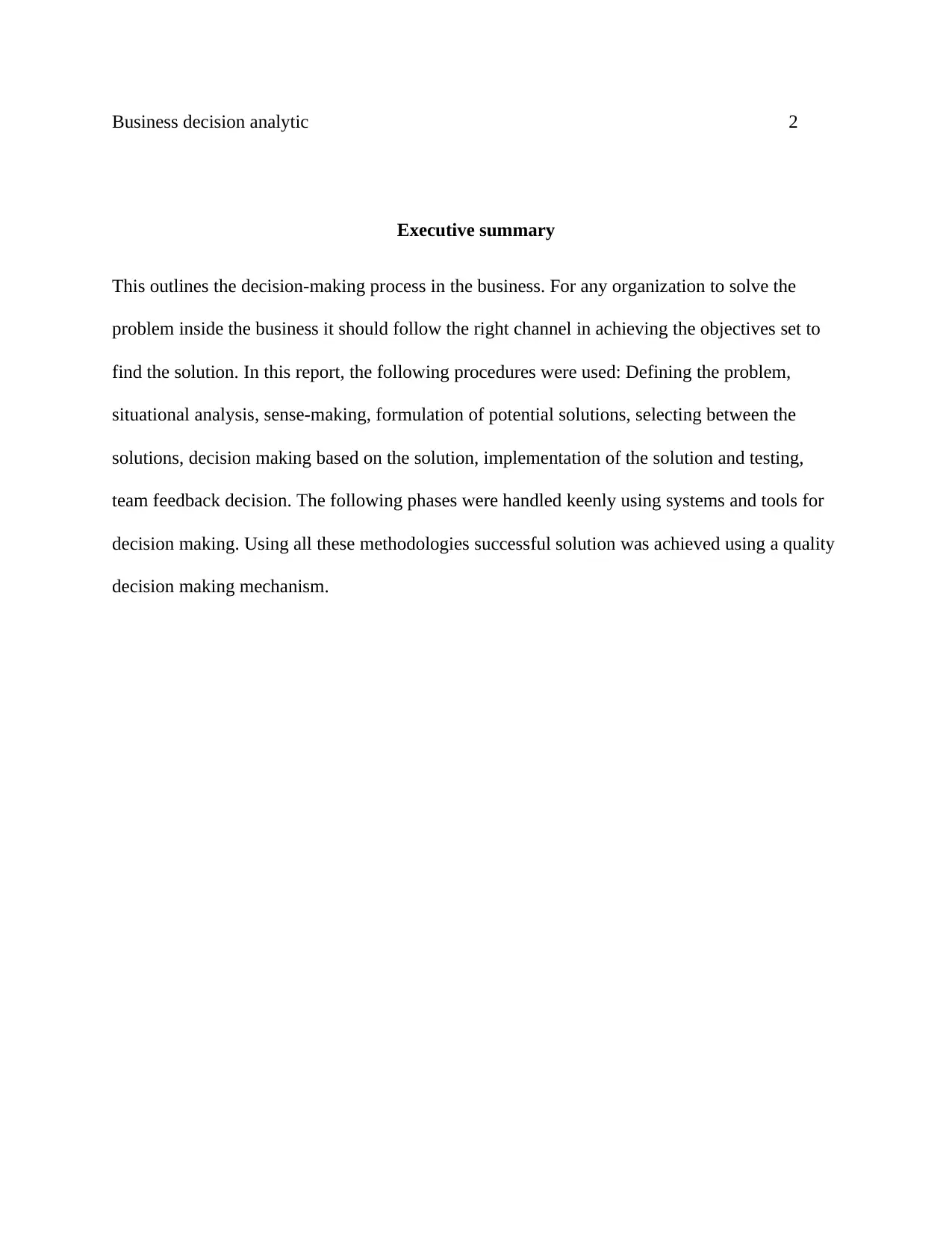
Business decision analytic 2
Executive summary
This outlines the decision-making process in the business. For any organization to solve the
problem inside the business it should follow the right channel in achieving the objectives set to
find the solution. In this report, the following procedures were used: Defining the problem,
situational analysis, sense-making, formulation of potential solutions, selecting between the
solutions, decision making based on the solution, implementation of the solution and testing,
team feedback decision. The following phases were handled keenly using systems and tools for
decision making. Using all these methodologies successful solution was achieved using a quality
decision making mechanism.
Executive summary
This outlines the decision-making process in the business. For any organization to solve the
problem inside the business it should follow the right channel in achieving the objectives set to
find the solution. In this report, the following procedures were used: Defining the problem,
situational analysis, sense-making, formulation of potential solutions, selecting between the
solutions, decision making based on the solution, implementation of the solution and testing,
team feedback decision. The following phases were handled keenly using systems and tools for
decision making. Using all these methodologies successful solution was achieved using a quality
decision making mechanism.
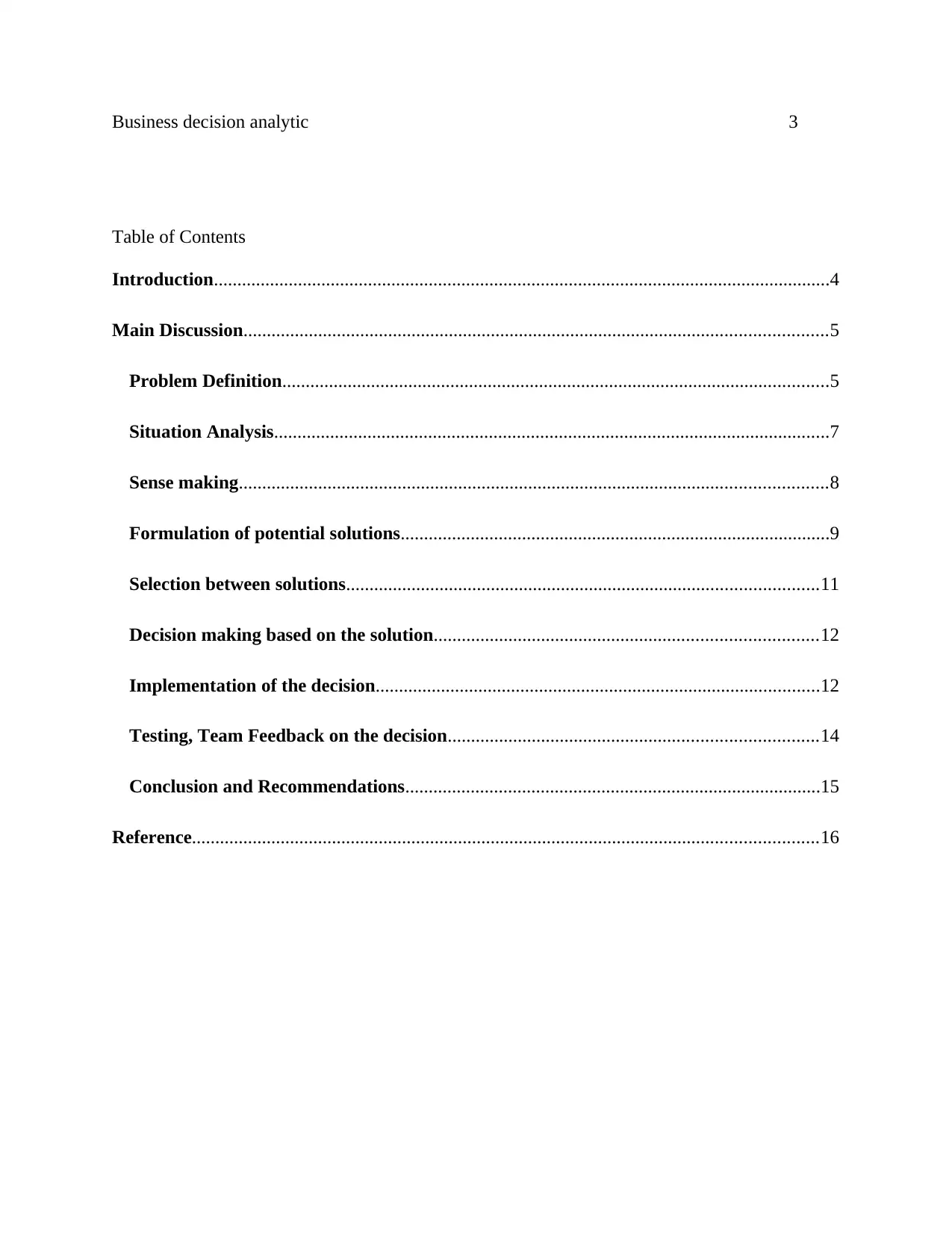
Business decision analytic 3
Table of Contents
Introduction....................................................................................................................................4
Main Discussion.............................................................................................................................5
Problem Definition.....................................................................................................................5
Situation Analysis.......................................................................................................................7
Sense making..............................................................................................................................8
Formulation of potential solutions............................................................................................9
Selection between solutions.....................................................................................................11
Decision making based on the solution..................................................................................12
Implementation of the decision...............................................................................................12
Testing, Team Feedback on the decision...............................................................................14
Conclusion and Recommendations.........................................................................................15
Reference......................................................................................................................................16
Table of Contents
Introduction....................................................................................................................................4
Main Discussion.............................................................................................................................5
Problem Definition.....................................................................................................................5
Situation Analysis.......................................................................................................................7
Sense making..............................................................................................................................8
Formulation of potential solutions............................................................................................9
Selection between solutions.....................................................................................................11
Decision making based on the solution..................................................................................12
Implementation of the decision...............................................................................................12
Testing, Team Feedback on the decision...............................................................................14
Conclusion and Recommendations.........................................................................................15
Reference......................................................................................................................................16
⊘ This is a preview!⊘
Do you want full access?
Subscribe today to unlock all pages.

Trusted by 1+ million students worldwide
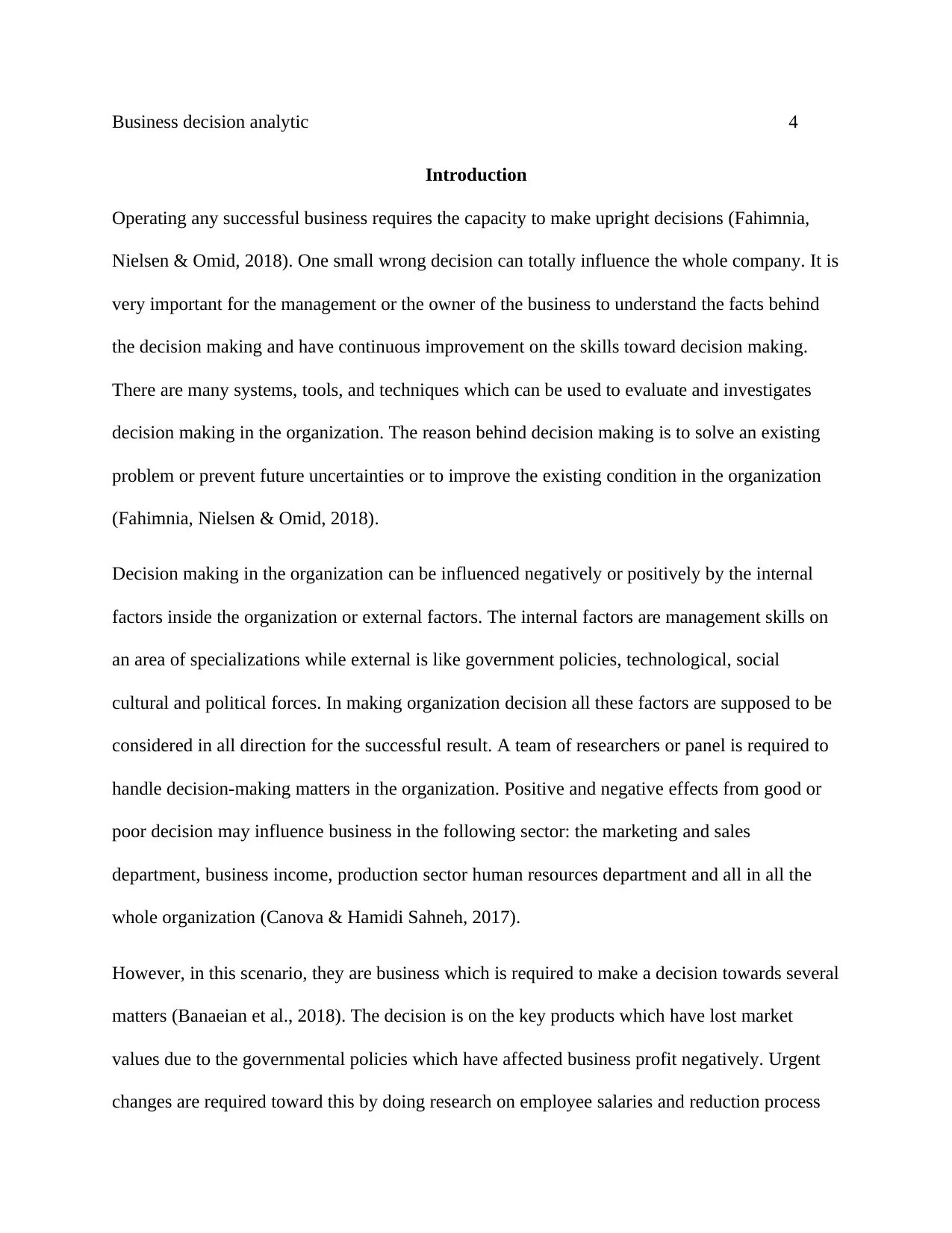
Business decision analytic 4
Introduction
Operating any successful business requires the capacity to make upright decisions (Fahimnia,
Nielsen & Omid, 2018). One small wrong decision can totally influence the whole company. It is
very important for the management or the owner of the business to understand the facts behind
the decision making and have continuous improvement on the skills toward decision making.
There are many systems, tools, and techniques which can be used to evaluate and investigates
decision making in the organization. The reason behind decision making is to solve an existing
problem or prevent future uncertainties or to improve the existing condition in the organization
(Fahimnia, Nielsen & Omid, 2018).
Decision making in the organization can be influenced negatively or positively by the internal
factors inside the organization or external factors. The internal factors are management skills on
an area of specializations while external is like government policies, technological, social
cultural and political forces. In making organization decision all these factors are supposed to be
considered in all direction for the successful result. A team of researchers or panel is required to
handle decision-making matters in the organization. Positive and negative effects from good or
poor decision may influence business in the following sector: the marketing and sales
department, business income, production sector human resources department and all in all the
whole organization (Canova & Hamidi Sahneh, 2017).
However, in this scenario, they are business which is required to make a decision towards several
matters (Banaeian et al., 2018). The decision is on the key products which have lost market
values due to the governmental policies which have affected business profit negatively. Urgent
changes are required toward this by doing research on employee salaries and reduction process
Introduction
Operating any successful business requires the capacity to make upright decisions (Fahimnia,
Nielsen & Omid, 2018). One small wrong decision can totally influence the whole company. It is
very important for the management or the owner of the business to understand the facts behind
the decision making and have continuous improvement on the skills toward decision making.
There are many systems, tools, and techniques which can be used to evaluate and investigates
decision making in the organization. The reason behind decision making is to solve an existing
problem or prevent future uncertainties or to improve the existing condition in the organization
(Fahimnia, Nielsen & Omid, 2018).
Decision making in the organization can be influenced negatively or positively by the internal
factors inside the organization or external factors. The internal factors are management skills on
an area of specializations while external is like government policies, technological, social
cultural and political forces. In making organization decision all these factors are supposed to be
considered in all direction for the successful result. A team of researchers or panel is required to
handle decision-making matters in the organization. Positive and negative effects from good or
poor decision may influence business in the following sector: the marketing and sales
department, business income, production sector human resources department and all in all the
whole organization (Canova & Hamidi Sahneh, 2017).
However, in this scenario, they are business which is required to make a decision towards several
matters (Banaeian et al., 2018). The decision is on the key products which have lost market
values due to the governmental policies which have affected business profit negatively. Urgent
changes are required toward this by doing research on employee salaries and reduction process
Paraphrase This Document
Need a fresh take? Get an instant paraphrase of this document with our AI Paraphraser
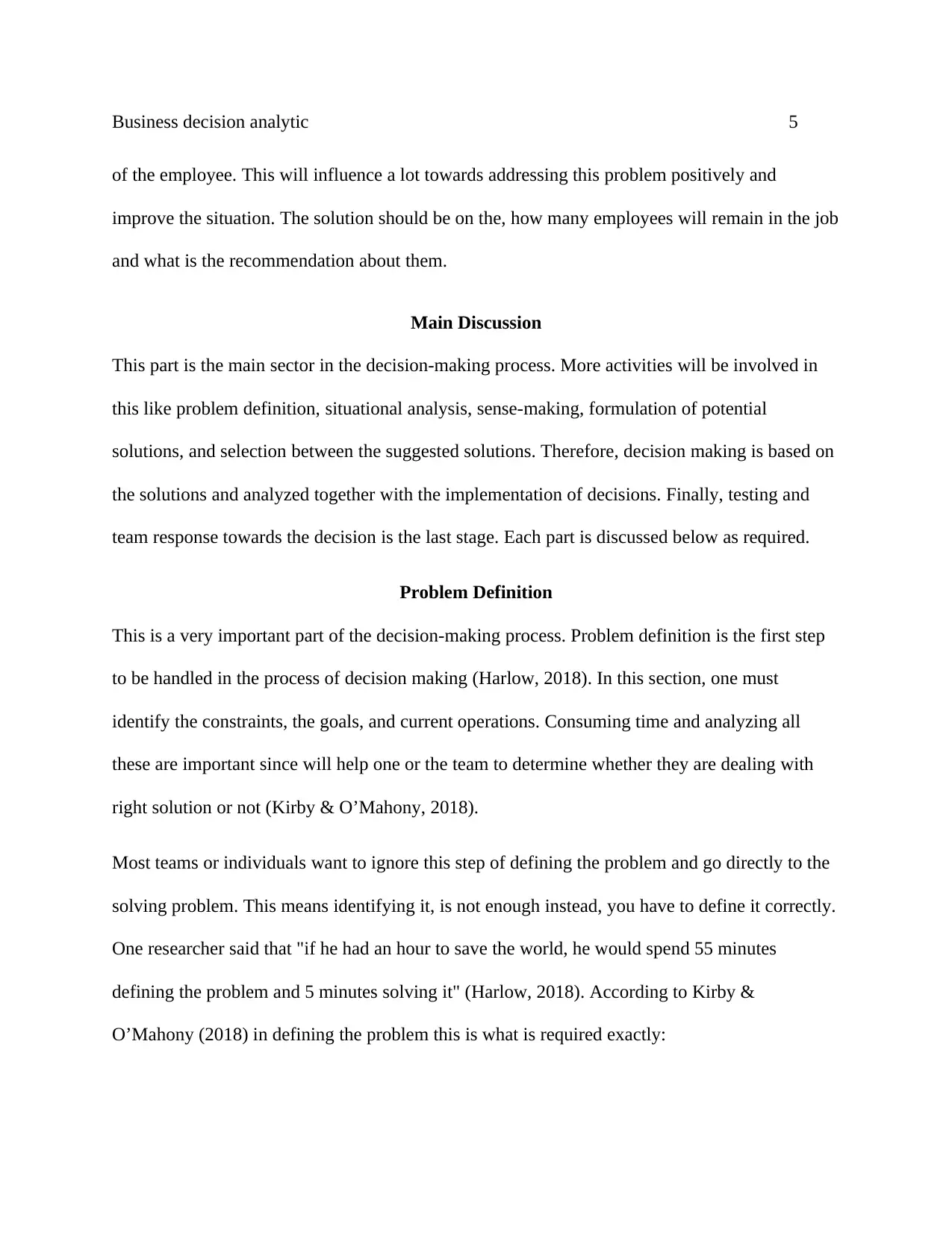
Business decision analytic 5
of the employee. This will influence a lot towards addressing this problem positively and
improve the situation. The solution should be on the, how many employees will remain in the job
and what is the recommendation about them.
Main Discussion
This part is the main sector in the decision-making process. More activities will be involved in
this like problem definition, situational analysis, sense-making, formulation of potential
solutions, and selection between the suggested solutions. Therefore, decision making is based on
the solutions and analyzed together with the implementation of decisions. Finally, testing and
team response towards the decision is the last stage. Each part is discussed below as required.
Problem Definition
This is a very important part of the decision-making process. Problem definition is the first step
to be handled in the process of decision making (Harlow, 2018). In this section, one must
identify the constraints, the goals, and current operations. Consuming time and analyzing all
these are important since will help one or the team to determine whether they are dealing with
right solution or not (Kirby & O’Mahony, 2018).
Most teams or individuals want to ignore this step of defining the problem and go directly to the
solving problem. This means identifying it, is not enough instead, you have to define it correctly.
One researcher said that "if he had an hour to save the world, he would spend 55 minutes
defining the problem and 5 minutes solving it" (Harlow, 2018). According to Kirby &
O’Mahony (2018) in defining the problem this is what is required exactly:
of the employee. This will influence a lot towards addressing this problem positively and
improve the situation. The solution should be on the, how many employees will remain in the job
and what is the recommendation about them.
Main Discussion
This part is the main sector in the decision-making process. More activities will be involved in
this like problem definition, situational analysis, sense-making, formulation of potential
solutions, and selection between the suggested solutions. Therefore, decision making is based on
the solutions and analyzed together with the implementation of decisions. Finally, testing and
team response towards the decision is the last stage. Each part is discussed below as required.
Problem Definition
This is a very important part of the decision-making process. Problem definition is the first step
to be handled in the process of decision making (Harlow, 2018). In this section, one must
identify the constraints, the goals, and current operations. Consuming time and analyzing all
these are important since will help one or the team to determine whether they are dealing with
right solution or not (Kirby & O’Mahony, 2018).
Most teams or individuals want to ignore this step of defining the problem and go directly to the
solving problem. This means identifying it, is not enough instead, you have to define it correctly.
One researcher said that "if he had an hour to save the world, he would spend 55 minutes
defining the problem and 5 minutes solving it" (Harlow, 2018). According to Kirby &
O’Mahony (2018) in defining the problem this is what is required exactly:
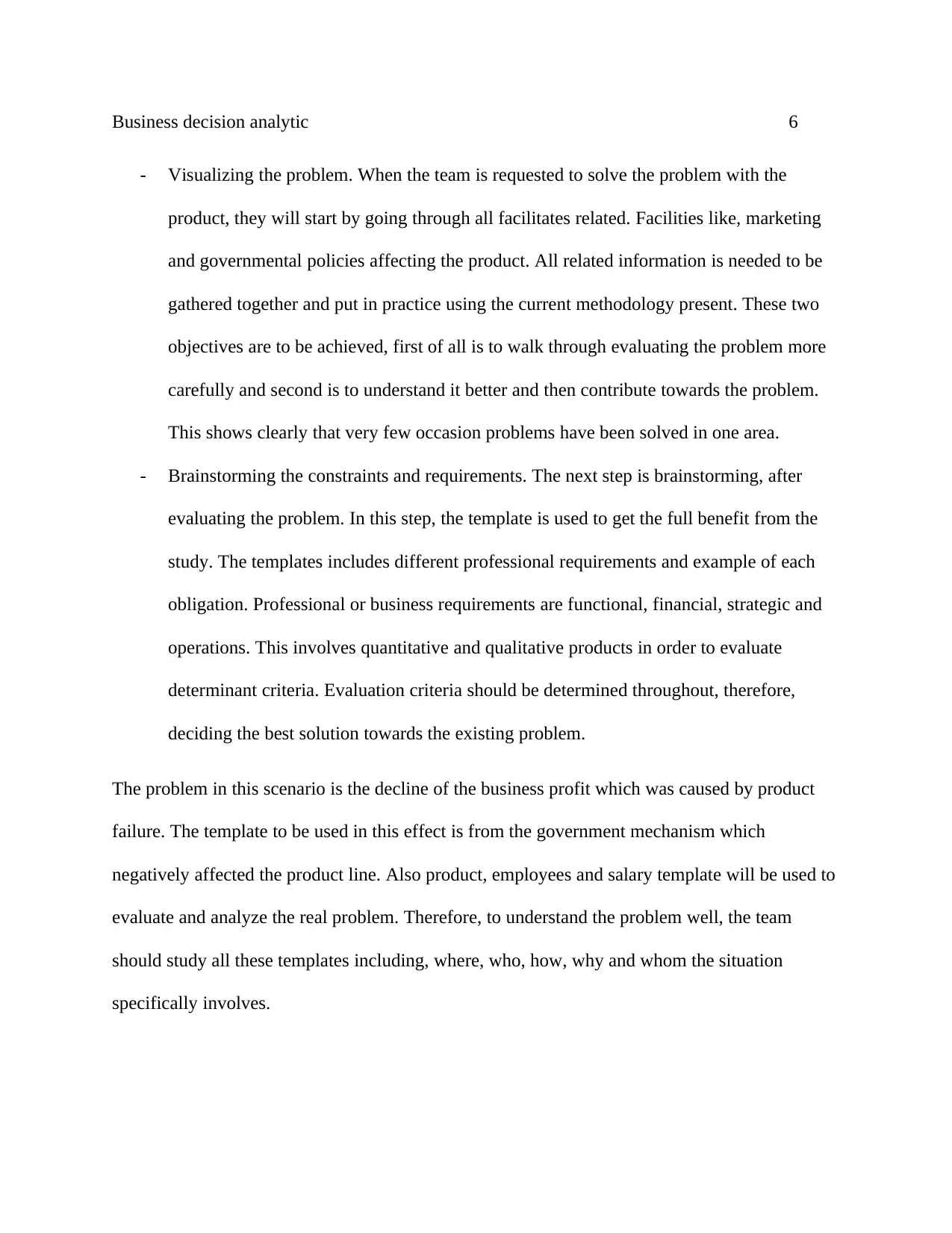
Business decision analytic 6
- Visualizing the problem. When the team is requested to solve the problem with the
product, they will start by going through all facilitates related. Facilities like, marketing
and governmental policies affecting the product. All related information is needed to be
gathered together and put in practice using the current methodology present. These two
objectives are to be achieved, first of all is to walk through evaluating the problem more
carefully and second is to understand it better and then contribute towards the problem.
This shows clearly that very few occasion problems have been solved in one area.
- Brainstorming the constraints and requirements. The next step is brainstorming, after
evaluating the problem. In this step, the template is used to get the full benefit from the
study. The templates includes different professional requirements and example of each
obligation. Professional or business requirements are functional, financial, strategic and
operations. This involves quantitative and qualitative products in order to evaluate
determinant criteria. Evaluation criteria should be determined throughout, therefore,
deciding the best solution towards the existing problem.
The problem in this scenario is the decline of the business profit which was caused by product
failure. The template to be used in this effect is from the government mechanism which
negatively affected the product line. Also product, employees and salary template will be used to
evaluate and analyze the real problem. Therefore, to understand the problem well, the team
should study all these templates including, where, who, how, why and whom the situation
specifically involves.
- Visualizing the problem. When the team is requested to solve the problem with the
product, they will start by going through all facilitates related. Facilities like, marketing
and governmental policies affecting the product. All related information is needed to be
gathered together and put in practice using the current methodology present. These two
objectives are to be achieved, first of all is to walk through evaluating the problem more
carefully and second is to understand it better and then contribute towards the problem.
This shows clearly that very few occasion problems have been solved in one area.
- Brainstorming the constraints and requirements. The next step is brainstorming, after
evaluating the problem. In this step, the template is used to get the full benefit from the
study. The templates includes different professional requirements and example of each
obligation. Professional or business requirements are functional, financial, strategic and
operations. This involves quantitative and qualitative products in order to evaluate
determinant criteria. Evaluation criteria should be determined throughout, therefore,
deciding the best solution towards the existing problem.
The problem in this scenario is the decline of the business profit which was caused by product
failure. The template to be used in this effect is from the government mechanism which
negatively affected the product line. Also product, employees and salary template will be used to
evaluate and analyze the real problem. Therefore, to understand the problem well, the team
should study all these templates including, where, who, how, why and whom the situation
specifically involves.
⊘ This is a preview!⊘
Do you want full access?
Subscribe today to unlock all pages.

Trusted by 1+ million students worldwide
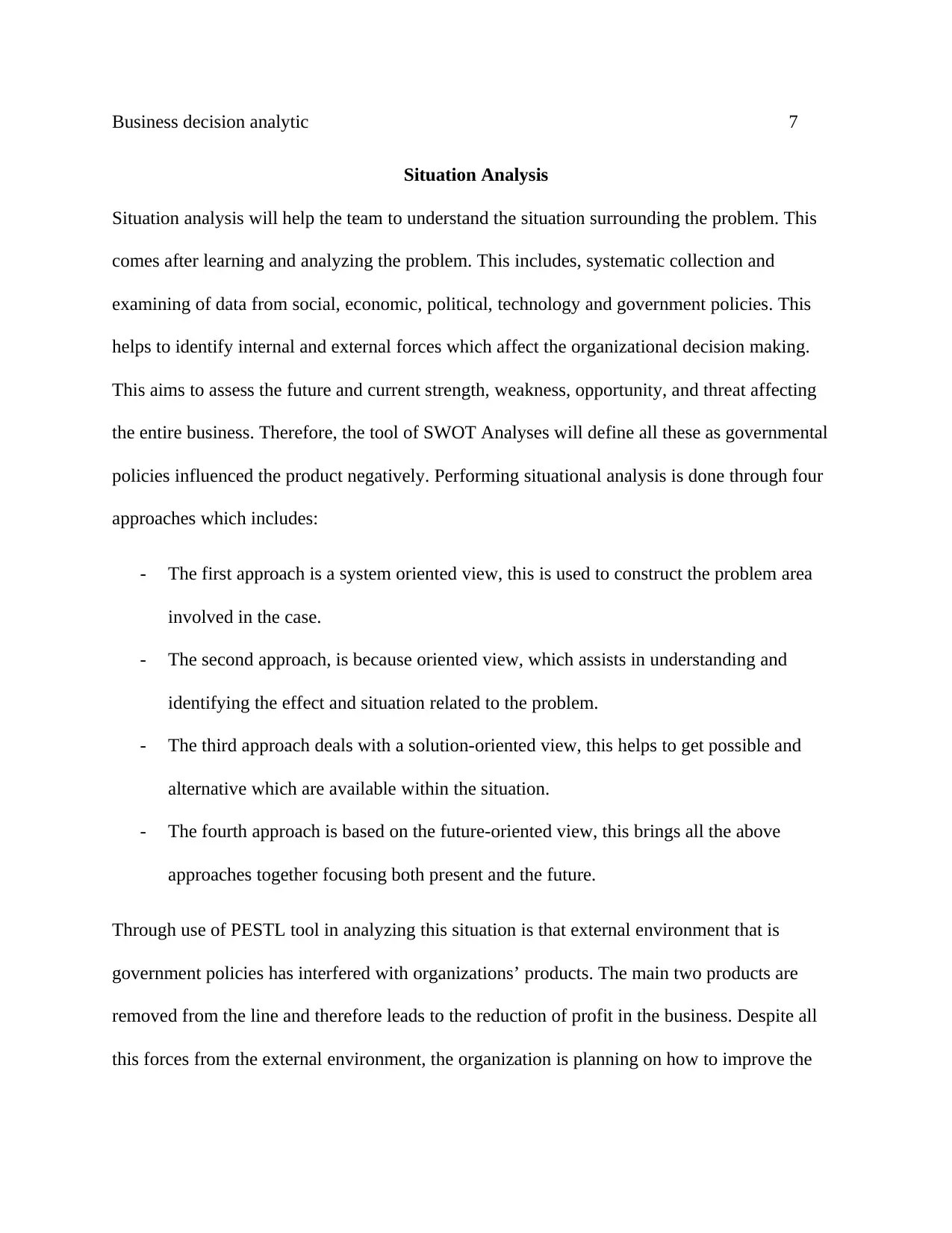
Business decision analytic 7
Situation Analysis
Situation analysis will help the team to understand the situation surrounding the problem. This
comes after learning and analyzing the problem. This includes, systematic collection and
examining of data from social, economic, political, technology and government policies. This
helps to identify internal and external forces which affect the organizational decision making.
This aims to assess the future and current strength, weakness, opportunity, and threat affecting
the entire business. Therefore, the tool of SWOT Analyses will define all these as governmental
policies influenced the product negatively. Performing situational analysis is done through four
approaches which includes:
- The first approach is a system oriented view, this is used to construct the problem area
involved in the case.
- The second approach, is because oriented view, which assists in understanding and
identifying the effect and situation related to the problem.
- The third approach deals with a solution-oriented view, this helps to get possible and
alternative which are available within the situation.
- The fourth approach is based on the future-oriented view, this brings all the above
approaches together focusing both present and the future.
Through use of PESTL tool in analyzing this situation is that external environment that is
government policies has interfered with organizations’ products. The main two products are
removed from the line and therefore leads to the reduction of profit in the business. Despite all
this forces from the external environment, the organization is planning on how to improve the
Situation Analysis
Situation analysis will help the team to understand the situation surrounding the problem. This
comes after learning and analyzing the problem. This includes, systematic collection and
examining of data from social, economic, political, technology and government policies. This
helps to identify internal and external forces which affect the organizational decision making.
This aims to assess the future and current strength, weakness, opportunity, and threat affecting
the entire business. Therefore, the tool of SWOT Analyses will define all these as governmental
policies influenced the product negatively. Performing situational analysis is done through four
approaches which includes:
- The first approach is a system oriented view, this is used to construct the problem area
involved in the case.
- The second approach, is because oriented view, which assists in understanding and
identifying the effect and situation related to the problem.
- The third approach deals with a solution-oriented view, this helps to get possible and
alternative which are available within the situation.
- The fourth approach is based on the future-oriented view, this brings all the above
approaches together focusing both present and the future.
Through use of PESTL tool in analyzing this situation is that external environment that is
government policies has interfered with organizations’ products. The main two products are
removed from the line and therefore leads to the reduction of profit in the business. Despite all
this forces from the external environment, the organization is planning on how to improve the
Paraphrase This Document
Need a fresh take? Get an instant paraphrase of this document with our AI Paraphraser
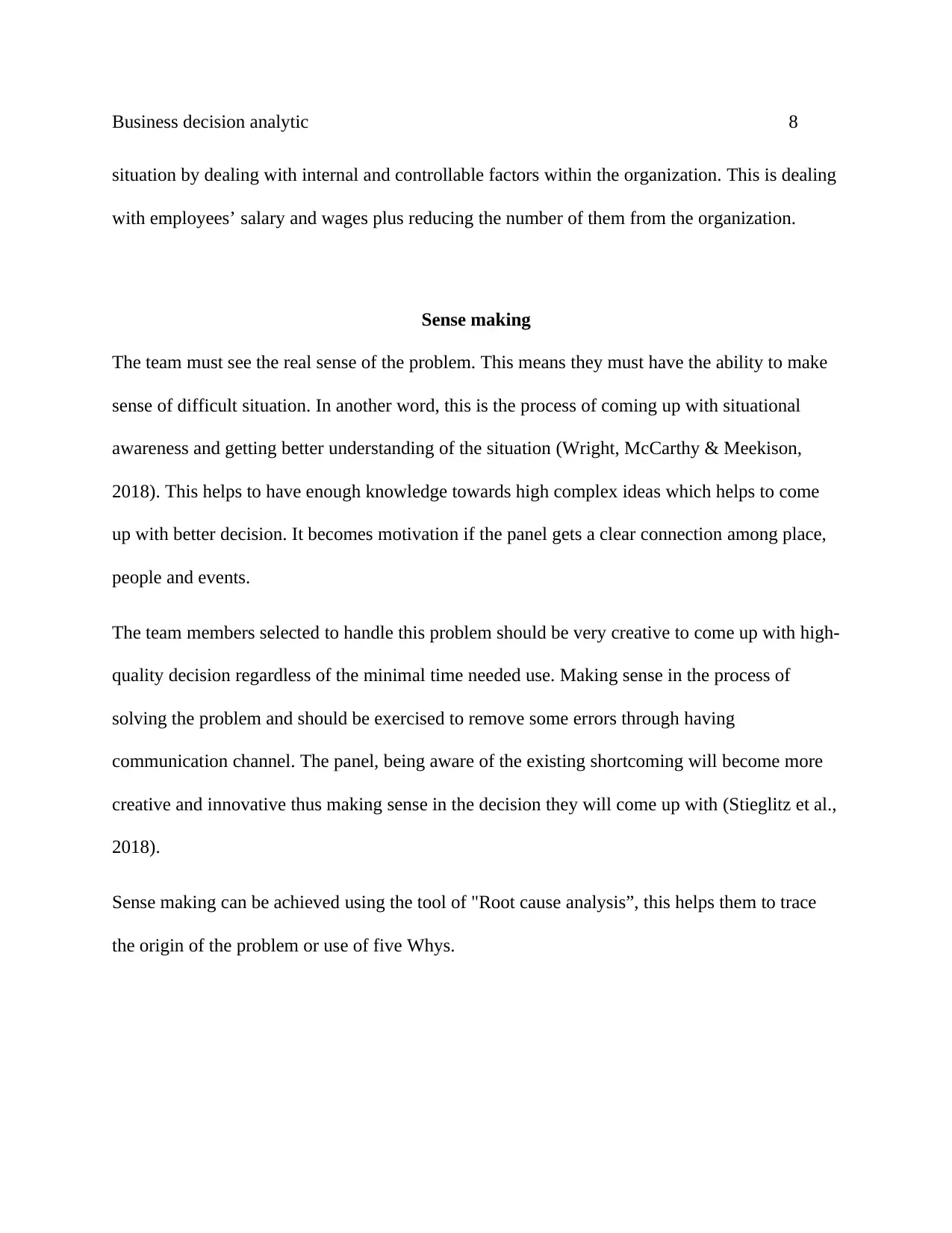
Business decision analytic 8
situation by dealing with internal and controllable factors within the organization. This is dealing
with employees’ salary and wages plus reducing the number of them from the organization.
Sense making
The team must see the real sense of the problem. This means they must have the ability to make
sense of difficult situation. In another word, this is the process of coming up with situational
awareness and getting better understanding of the situation (Wright, McCarthy & Meekison,
2018). This helps to have enough knowledge towards high complex ideas which helps to come
up with better decision. It becomes motivation if the panel gets a clear connection among place,
people and events.
The team members selected to handle this problem should be very creative to come up with high-
quality decision regardless of the minimal time needed use. Making sense in the process of
solving the problem and should be exercised to remove some errors through having
communication channel. The panel, being aware of the existing shortcoming will become more
creative and innovative thus making sense in the decision they will come up with (Stieglitz et al.,
2018).
Sense making can be achieved using the tool of "Root cause analysis”, this helps them to trace
the origin of the problem or use of five Whys.
situation by dealing with internal and controllable factors within the organization. This is dealing
with employees’ salary and wages plus reducing the number of them from the organization.
Sense making
The team must see the real sense of the problem. This means they must have the ability to make
sense of difficult situation. In another word, this is the process of coming up with situational
awareness and getting better understanding of the situation (Wright, McCarthy & Meekison,
2018). This helps to have enough knowledge towards high complex ideas which helps to come
up with better decision. It becomes motivation if the panel gets a clear connection among place,
people and events.
The team members selected to handle this problem should be very creative to come up with high-
quality decision regardless of the minimal time needed use. Making sense in the process of
solving the problem and should be exercised to remove some errors through having
communication channel. The panel, being aware of the existing shortcoming will become more
creative and innovative thus making sense in the decision they will come up with (Stieglitz et al.,
2018).
Sense making can be achieved using the tool of "Root cause analysis”, this helps them to trace
the origin of the problem or use of five Whys.
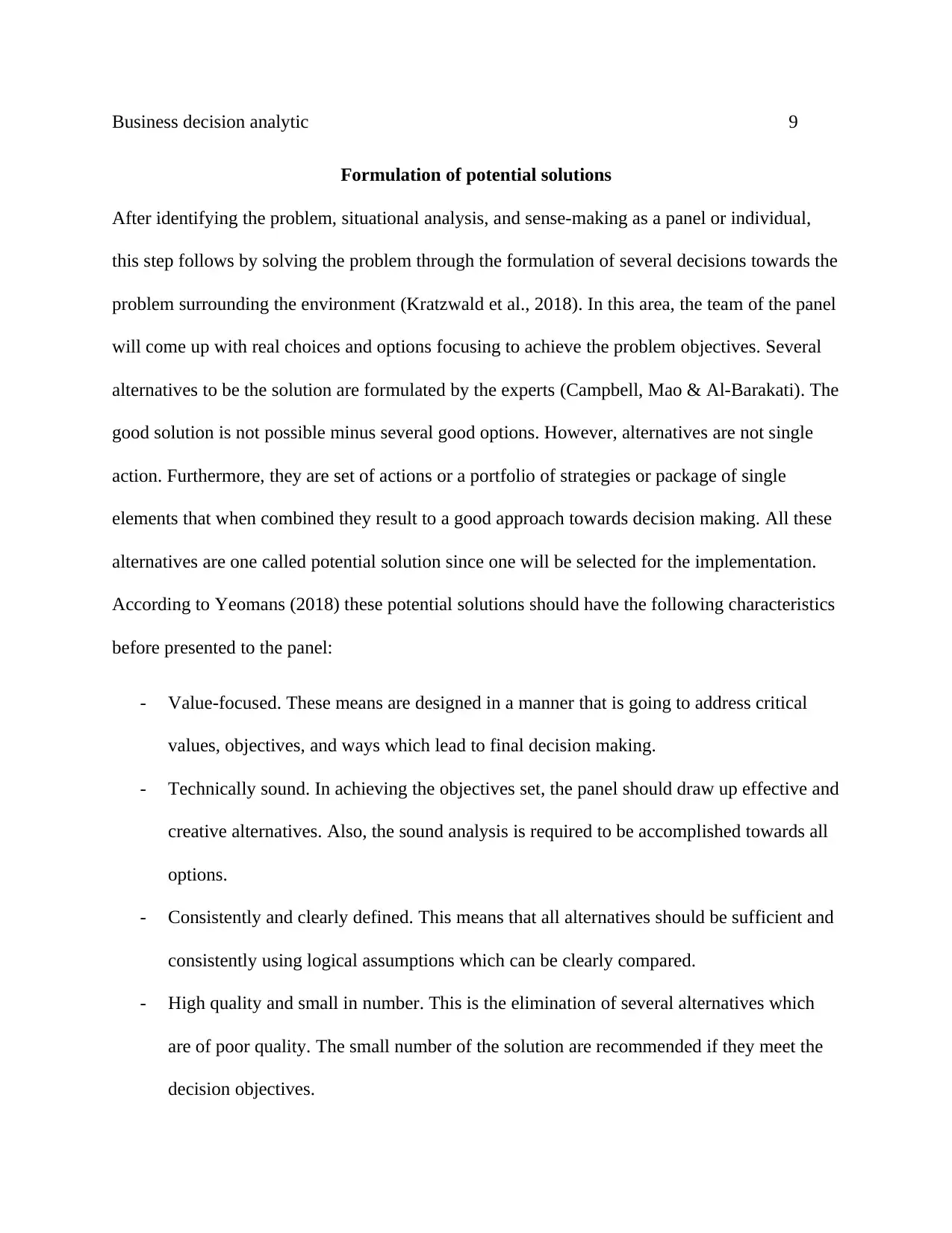
Business decision analytic 9
Formulation of potential solutions
After identifying the problem, situational analysis, and sense-making as a panel or individual,
this step follows by solving the problem through the formulation of several decisions towards the
problem surrounding the environment (Kratzwald et al., 2018). In this area, the team of the panel
will come up with real choices and options focusing to achieve the problem objectives. Several
alternatives to be the solution are formulated by the experts (Campbell, Mao & Al-Barakati). The
good solution is not possible minus several good options. However, alternatives are not single
action. Furthermore, they are set of actions or a portfolio of strategies or package of single
elements that when combined they result to a good approach towards decision making. All these
alternatives are one called potential solution since one will be selected for the implementation.
According to Yeomans (2018) these potential solutions should have the following characteristics
before presented to the panel:
- Value-focused. These means are designed in a manner that is going to address critical
values, objectives, and ways which lead to final decision making.
- Technically sound. In achieving the objectives set, the panel should draw up effective and
creative alternatives. Also, the sound analysis is required to be accomplished towards all
options.
- Consistently and clearly defined. This means that all alternatives should be sufficient and
consistently using logical assumptions which can be clearly compared.
- High quality and small in number. This is the elimination of several alternatives which
are of poor quality. The small number of the solution are recommended if they meet the
decision objectives.
Formulation of potential solutions
After identifying the problem, situational analysis, and sense-making as a panel or individual,
this step follows by solving the problem through the formulation of several decisions towards the
problem surrounding the environment (Kratzwald et al., 2018). In this area, the team of the panel
will come up with real choices and options focusing to achieve the problem objectives. Several
alternatives to be the solution are formulated by the experts (Campbell, Mao & Al-Barakati). The
good solution is not possible minus several good options. However, alternatives are not single
action. Furthermore, they are set of actions or a portfolio of strategies or package of single
elements that when combined they result to a good approach towards decision making. All these
alternatives are one called potential solution since one will be selected for the implementation.
According to Yeomans (2018) these potential solutions should have the following characteristics
before presented to the panel:
- Value-focused. These means are designed in a manner that is going to address critical
values, objectives, and ways which lead to final decision making.
- Technically sound. In achieving the objectives set, the panel should draw up effective and
creative alternatives. Also, the sound analysis is required to be accomplished towards all
options.
- Consistently and clearly defined. This means that all alternatives should be sufficient and
consistently using logical assumptions which can be clearly compared.
- High quality and small in number. This is the elimination of several alternatives which
are of poor quality. The small number of the solution are recommended if they meet the
decision objectives.
⊘ This is a preview!⊘
Do you want full access?
Subscribe today to unlock all pages.

Trusted by 1+ million students worldwide
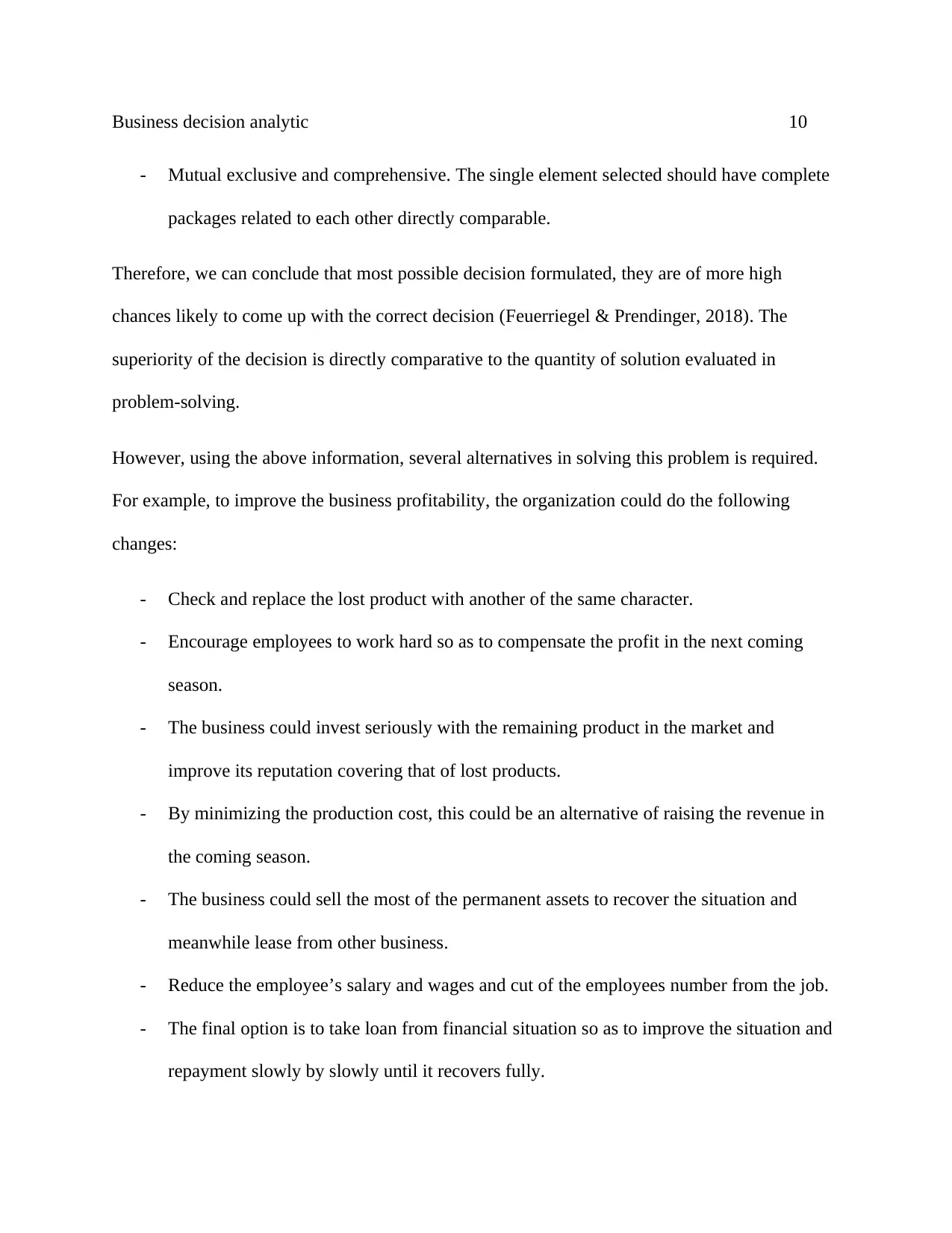
Business decision analytic 10
- Mutual exclusive and comprehensive. The single element selected should have complete
packages related to each other directly comparable.
Therefore, we can conclude that most possible decision formulated, they are of more high
chances likely to come up with the correct decision (Feuerriegel & Prendinger, 2018). The
superiority of the decision is directly comparative to the quantity of solution evaluated in
problem-solving.
However, using the above information, several alternatives in solving this problem is required.
For example, to improve the business profitability, the organization could do the following
changes:
- Check and replace the lost product with another of the same character.
- Encourage employees to work hard so as to compensate the profit in the next coming
season.
- The business could invest seriously with the remaining product in the market and
improve its reputation covering that of lost products.
- By minimizing the production cost, this could be an alternative of raising the revenue in
the coming season.
- The business could sell the most of the permanent assets to recover the situation and
meanwhile lease from other business.
- Reduce the employee’s salary and wages and cut of the employees number from the job.
- The final option is to take loan from financial situation so as to improve the situation and
repayment slowly by slowly until it recovers fully.
- Mutual exclusive and comprehensive. The single element selected should have complete
packages related to each other directly comparable.
Therefore, we can conclude that most possible decision formulated, they are of more high
chances likely to come up with the correct decision (Feuerriegel & Prendinger, 2018). The
superiority of the decision is directly comparative to the quantity of solution evaluated in
problem-solving.
However, using the above information, several alternatives in solving this problem is required.
For example, to improve the business profitability, the organization could do the following
changes:
- Check and replace the lost product with another of the same character.
- Encourage employees to work hard so as to compensate the profit in the next coming
season.
- The business could invest seriously with the remaining product in the market and
improve its reputation covering that of lost products.
- By minimizing the production cost, this could be an alternative of raising the revenue in
the coming season.
- The business could sell the most of the permanent assets to recover the situation and
meanwhile lease from other business.
- Reduce the employee’s salary and wages and cut of the employees number from the job.
- The final option is to take loan from financial situation so as to improve the situation and
repayment slowly by slowly until it recovers fully.
Paraphrase This Document
Need a fresh take? Get an instant paraphrase of this document with our AI Paraphraser
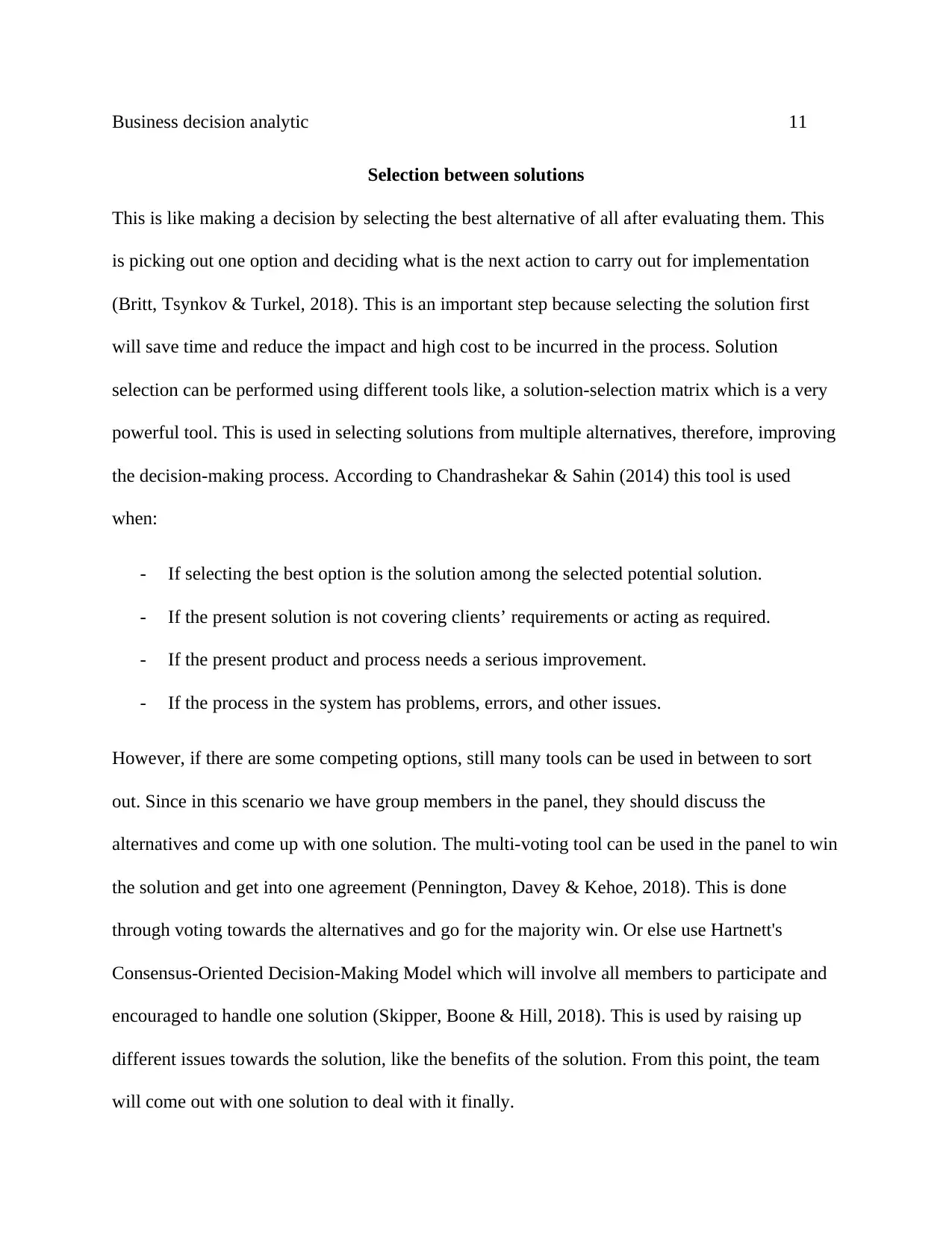
Business decision analytic 11
Selection between solutions
This is like making a decision by selecting the best alternative of all after evaluating them. This
is picking out one option and deciding what is the next action to carry out for implementation
(Britt, Tsynkov & Turkel, 2018). This is an important step because selecting the solution first
will save time and reduce the impact and high cost to be incurred in the process. Solution
selection can be performed using different tools like, a solution-selection matrix which is a very
powerful tool. This is used in selecting solutions from multiple alternatives, therefore, improving
the decision-making process. According to Chandrashekar & Sahin (2014) this tool is used
when:
- If selecting the best option is the solution among the selected potential solution.
- If the present solution is not covering clients’ requirements or acting as required.
- If the present product and process needs a serious improvement.
- If the process in the system has problems, errors, and other issues.
However, if there are some competing options, still many tools can be used in between to sort
out. Since in this scenario we have group members in the panel, they should discuss the
alternatives and come up with one solution. The multi-voting tool can be used in the panel to win
the solution and get into one agreement (Pennington, Davey & Kehoe, 2018). This is done
through voting towards the alternatives and go for the majority win. Or else use Hartnett's
Consensus-Oriented Decision-Making Model which will involve all members to participate and
encouraged to handle one solution (Skipper, Boone & Hill, 2018). This is used by raising up
different issues towards the solution, like the benefits of the solution. From this point, the team
will come out with one solution to deal with it finally.
Selection between solutions
This is like making a decision by selecting the best alternative of all after evaluating them. This
is picking out one option and deciding what is the next action to carry out for implementation
(Britt, Tsynkov & Turkel, 2018). This is an important step because selecting the solution first
will save time and reduce the impact and high cost to be incurred in the process. Solution
selection can be performed using different tools like, a solution-selection matrix which is a very
powerful tool. This is used in selecting solutions from multiple alternatives, therefore, improving
the decision-making process. According to Chandrashekar & Sahin (2014) this tool is used
when:
- If selecting the best option is the solution among the selected potential solution.
- If the present solution is not covering clients’ requirements or acting as required.
- If the present product and process needs a serious improvement.
- If the process in the system has problems, errors, and other issues.
However, if there are some competing options, still many tools can be used in between to sort
out. Since in this scenario we have group members in the panel, they should discuss the
alternatives and come up with one solution. The multi-voting tool can be used in the panel to win
the solution and get into one agreement (Pennington, Davey & Kehoe, 2018). This is done
through voting towards the alternatives and go for the majority win. Or else use Hartnett's
Consensus-Oriented Decision-Making Model which will involve all members to participate and
encouraged to handle one solution (Skipper, Boone & Hill, 2018). This is used by raising up
different issues towards the solution, like the benefits of the solution. From this point, the team
will come out with one solution to deal with it finally.
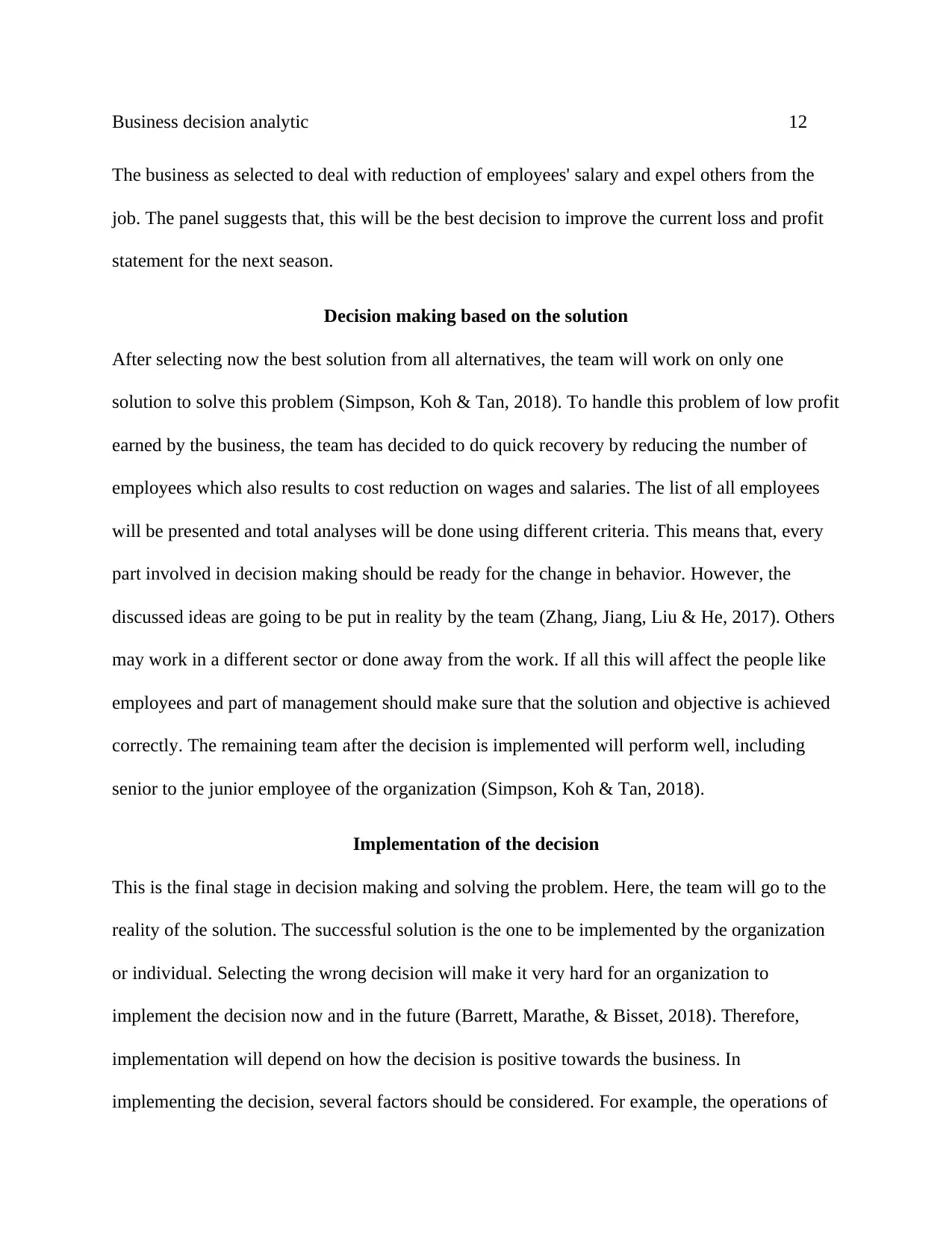
Business decision analytic 12
The business as selected to deal with reduction of employees' salary and expel others from the
job. The panel suggests that, this will be the best decision to improve the current loss and profit
statement for the next season.
Decision making based on the solution
After selecting now the best solution from all alternatives, the team will work on only one
solution to solve this problem (Simpson, Koh & Tan, 2018). To handle this problem of low profit
earned by the business, the team has decided to do quick recovery by reducing the number of
employees which also results to cost reduction on wages and salaries. The list of all employees
will be presented and total analyses will be done using different criteria. This means that, every
part involved in decision making should be ready for the change in behavior. However, the
discussed ideas are going to be put in reality by the team (Zhang, Jiang, Liu & He, 2017). Others
may work in a different sector or done away from the work. If all this will affect the people like
employees and part of management should make sure that the solution and objective is achieved
correctly. The remaining team after the decision is implemented will perform well, including
senior to the junior employee of the organization (Simpson, Koh & Tan, 2018).
Implementation of the decision
This is the final stage in decision making and solving the problem. Here, the team will go to the
reality of the solution. The successful solution is the one to be implemented by the organization
or individual. Selecting the wrong decision will make it very hard for an organization to
implement the decision now and in the future (Barrett, Marathe, & Bisset, 2018). Therefore,
implementation will depend on how the decision is positive towards the business. In
implementing the decision, several factors should be considered. For example, the operations of
The business as selected to deal with reduction of employees' salary and expel others from the
job. The panel suggests that, this will be the best decision to improve the current loss and profit
statement for the next season.
Decision making based on the solution
After selecting now the best solution from all alternatives, the team will work on only one
solution to solve this problem (Simpson, Koh & Tan, 2018). To handle this problem of low profit
earned by the business, the team has decided to do quick recovery by reducing the number of
employees which also results to cost reduction on wages and salaries. The list of all employees
will be presented and total analyses will be done using different criteria. This means that, every
part involved in decision making should be ready for the change in behavior. However, the
discussed ideas are going to be put in reality by the team (Zhang, Jiang, Liu & He, 2017). Others
may work in a different sector or done away from the work. If all this will affect the people like
employees and part of management should make sure that the solution and objective is achieved
correctly. The remaining team after the decision is implemented will perform well, including
senior to the junior employee of the organization (Simpson, Koh & Tan, 2018).
Implementation of the decision
This is the final stage in decision making and solving the problem. Here, the team will go to the
reality of the solution. The successful solution is the one to be implemented by the organization
or individual. Selecting the wrong decision will make it very hard for an organization to
implement the decision now and in the future (Barrett, Marathe, & Bisset, 2018). Therefore,
implementation will depend on how the decision is positive towards the business. In
implementing the decision, several factors should be considered. For example, the operations of
⊘ This is a preview!⊘
Do you want full access?
Subscribe today to unlock all pages.

Trusted by 1+ million students worldwide
1 out of 20
Related Documents
Your All-in-One AI-Powered Toolkit for Academic Success.
+13062052269
info@desklib.com
Available 24*7 on WhatsApp / Email
![[object Object]](/_next/static/media/star-bottom.7253800d.svg)
Unlock your academic potential
Copyright © 2020–2025 A2Z Services. All Rights Reserved. Developed and managed by ZUCOL.




